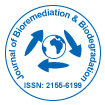Microalgae-Based Bioremediation: Sustainable Solutions for Heavy Metal and Nutrient Contamination
Received Date: Mar 03, 2025 / Accepted Date: Mar 30, 2025 / Published Date: Mar 30, 2025
Abstract
Microalgae-based bioremediation has emerged as an eco-friendly and sustainable solution to address environmental pollution, specifically the contamination of heavy metals and excess nutrients in aquatic ecosystems. This bioremediation process utilizes the natural metabolic abilities of microalgae to absorb, accumulate, and detoxify pollutants, offering a promising alternative to conventional treatment methods. The ability of microalgae to remove toxic metals like cadmium, lead, and mercury, as well as excess nutrients such as nitrogen and phosphorus, has been demonstrated in various studies. Moreover, microalgae bioremediation provides additional benefits such as biomass production, which can be used for biofuels, animal feed, and other value-added products. This review discusses the mechanisms behind microalgae’s pollutant uptake, factors influencing bioremediation efficiency, and potential applications in real-world environmental management.
Citation: Summoned B (2025) Microalgae-Based Bioremediation: SustainableSolutions for Heavy Metal and Nutrient Contamination. J Bioremediat Biodegrad,16: 673.
Copyright: © 2025 Summoned B. This is an open-access article distributed underthe terms of the Creative Commons Attribution License, which permits unrestricteduse, distribution, and reproduction in any medium, provided the original author andsource are credited
Select your language of interest to view the total content in your interested language
Share This Article
Recommended Journals
Open Access Journals
Article Usage
- Total views: 284
- [From(publication date): 0-0 - Nov 11, 2025]
- Breakdown by view type
- HTML page views: 208
- PDF downloads: 76
